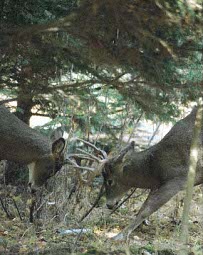|
Here is where we will discuss projectiles. You have basically 2 choices. You can use a round ball with a patch, or some type
of elongated bullet (known as a conical).
If you choose to use a roundball most rifles have 2-3 sizes available
for that said caliber. For example take my .40 caliber. I've seen roundballs in the diameter of .390, .395, .400 and .405.
By trying different sized roundballs and different thicknesses of patches you can really develop a "pet load" for
your rifle. Something that I think is much more difficult to achieve with a conical shooter. You don't have as many choices
in bullets. Roundballs are always undersized with the remaining size difference being taken up by the patch material.
In a .32 caliber the ball size is .315 diameter.
In a .36 caliber the most often size seen is the .350 diameter.
For a .45 the roundball the most often size seen is .440 diameter.
For a .50 caliber the most often seen
size is .490 diameter.
For a .54 caliber the most often seen size is the .530 diameter.
Just remember that
you want to keep everything as consistent as possible to ensure optimum accuracy in your rifle. For patching make sure whatever
you do choose, that it is 100% cotton. If you make a mistake and get a fabric that contains any synthetic stuff in it you
will have a big mess on your hands as it will melt in the bore when shot and be a devil to get out.
Also keep in
mind that you have to find a lube for your patches. I have tried 1000+ but honestly I do not trust it any longer. We found
3 rifles that developed rust after using this lube as a rust preventer. Also over time (and a few hundred rounds or so put
through the rifle) it will develop a tar like build up in the bore. It will take something like wd-40, gasoline or carburetor
cleaner to remove it. You will have to scrub the bore with a bore brush, let it soak and then use patches to remove it and
begin again. This is a long process.
We have recently begun using a new lube (new to us) that was brought to our
attention by a friend. It's called moose milk. It's something anyone can make at home. The recipe for this lube is on it's
own link. I will repeat something I stated on that page. THIS LUBE IS INTENDED ONLY FOR A PATCH LUBE AND NOT FOR RUST PREVENTION.
The oil used is water soluble and can absorb moisture from the atmosphere which could result in rust in the bore if used in
this manner.
For elongated bullets you have several choices. Here are some of them: maxi-balls, maxi-hunters, Lee
real bullets, buffalo bullets, and various elongated bullets used with sabots.
Let's go into the sabots first. The
sabot (pronounced say-bo) is a plastic container. It's got plastic fingers on it that flare out after the weapon is fired
and allow the bullet to keep going while it falls to the ground. The base of the sabot has a slight hollow base to conform
to the powder charge. Depending on the sabot you choose will also dictate what size bullets you need to use inside of it.
There are many brands of sabots and each use different bullets. One thing to note here is that these bullets are normally
pointed and they are straight without any grease bands with a solid base as well. Some even go to .50 caliber bullet in a
.54 caliber rifle. This particular type is made by Knight. Some use .38 pistol pullets. You just need to read on the package
and determine whether they are correct for your rifle.
First of all the all lead elongated conicals like maxi-balls,
maxi-hunters, and others like it, you will notice they appear different than sabot type projectiles. Unlike the sabot bullets
a maxi-ball, maxi-hunter type will have grease bands. These bands are in between the base and the nose with one seperator
band in between. This seperator band is slightly undersize in bore diameter and you can thumb start a conical till you get
to the bottom of the nose section of the bullet. Then the bullet is true bore size and you need your ramrod. The idea behind
the grease rings or bands is to aid in keeping the lead from building up in the barrel. Maxi-balls are pointy at the top where
as maxi-hunters have a slight hollow point that is designed to expand more readily on deer sized game. There are many types
of conicals to choose from as well. You need to buy several and shoot them and see which your rifle prefers. Every rifle is
different just as every shooter is different and no 2 rifles, even if made back to back, will shoot identically.

|




